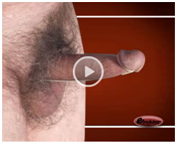5- Orchiectomy
Orchiectomy (also named orchidectomy, and sometimes shortened as
orchi) is a surgical procedure to remove one or both testicles (testes). The
removal of both testicles specifically can be referred to as a bilateral
orchiectomy.
There are three main types of orchiectomy: simple, subcapsular, and
inguinal. The first two types are usually done under local or epidural
anesthesia, and take about 30 minutes to perform. An inguinal orchiectomy is
sometimes done under general anesthesia, and takes between 30 minutes and an
hour to complete.
Simple orchiectomy
A simple orchiectomy is commonly performed as part of sex
reassignment surgery (SRS) for transgender women, or as palliative treatment
for advanced cases of prostate cancer. The patient lies flat on an operating
table with the penis taped against the abdomen. After anesthetic has been
administered, the surgeon makes an incision in the midpoint of the scrotum and
cuts through the underlying tissue. The surgeon removes the testicles and parts
of the spermatic cord through the incision. The incision is closed with two
layers of sutures and covered with a surgical dressing. If the patient desires,
a prosthetic testicle can be inserted before the incision is closed to present
an outward appearance of a pre-surgical scrotum.
Subcapsular orchiectomy
A subcapsular orchiectomy is also commonly performed for treatment
of prostate cancer. The operation is similar to that of a simple orchiectomy,
with the exception that the glandular tissue that surrounds each testicle is
removed rather than the entire gland itself. This type of orchiectomy is done
primarily to keep the appearance of an ordinary scrotum.
Inguinal orchiectomy
Inguinal orchiectomy (named from the Latin inguin for
"groin," and also called radical orchiectomy), is performed when an
onset of testicular cancer is suspected, in order to prevent a possible spread
of cancer from the spermatic cord into the lymph nodes near the kidneys.
An inguinal orchiectomy can be either unilateral or bilateral. The
surgeon makes an incision in the patient's groin area (in contrast to an
incision in the scrotum, as is done in both simple and subcapsular
orchiectomies). The entire spermatic cord is removed, as well as the testicle(s).
A long, non-absorbable suture may be left in the stump of the spermatic cord
in case later surgery is deemed necessary.
After the cord and testicle have been removed, the surgeon washes
the area with saline solution and closes the various layers of tissues and skin
with various types of sutures. The wound is then covered with sterile gauze and
bandaged.



